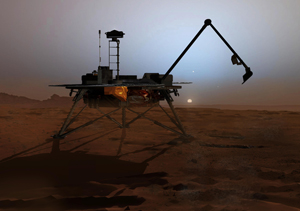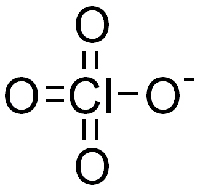 In the late 1970s, NASA landed two probes on the Martian surface. The Viking missions were designed to scoop up surface material and examine it for indications of life.
In the late 1970s, NASA landed two probes on the Martian surface. The Viking missions were designed to scoop up surface material and examine it for indications of life.
What was expected was for the missions to detect organic compounds: carbon-based molecules like amino acids that make up the building blocks of life. Instead, the results they got were disappointing. Instead of organics, they found compounds of chlorine like chloromethane and dichloromethane, which were interpreted as contamination from labs back on Earth (from cleaning fluids!).
 However, in 2008, the Mars Phoenix lander did its own scooping, and found something unexpected: perchlorate. This molecule is made up of one chlorine atom and four oxygen atoms (ClO4) and has the interesting property of being very reactive with organic molecules. It’s found naturally on Earth, too.
However, in 2008, the Mars Phoenix lander did its own scooping, and found something unexpected: perchlorate. This molecule is made up of one chlorine atom and four oxygen atoms (ClO4) and has the interesting property of being very reactive with organic molecules. It’s found naturally on Earth, too.
What’s so very interesting about this is that recently, scientists took samples of soil in Chile, added perchlorate, and then analyzed those samples in the same way Viking did. Guess what they got? Yup: chloromethane and dichloromethane.
So what does this mean? Well, it would solve the Viking mystery! The chemicals the Viking landers detected more than 30 years ago may have been the result of organics in the Martian soil reacting with naturally occurring perchlorates. That would explain why there were no organics, as well as the chemicals they did find.
Mind you, this does not mean Mars has life. But it does mean that if organic molecules are on Mars – and we expect them to be; for one thing they’re commonly found in meteorites on Earth, which would hit Mars as well, and many organic compounds are created relatively easily naturally – then they may get zapped by perchlorates.
So it’s still possible that Mars may have the precursors for life on or near its surface, but not likely where perchlorates are hanging out. If perchlorates are common this may make it less likely for us to find complex organic molecules. But we should note that the presence of chloromethane and dichloromethane implies that organic molecules did once exist there!
Again, this doesn’t mean life, but it does mean that conditions on Mars were once able to support the presence of organics. The search for life, extant or extinct, on Mars is like a giant jigsaw puzzle, and one more piece has been placed in it. There’s still perhaps a long way to go, but every step gets us a little closer.
Image Credit: NASA/JPL-Caltech/University of Arizona, Wikipedia Commons